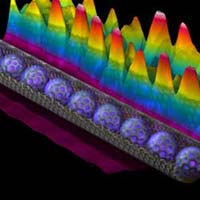Nanotube ’Peapods’ Exhibit Surprising Electronic Properties

Image: D. Hornbaker and A. Yazdani
In yet another small step toward building nanoscale devices, scientists have determined that nanotube peapods — minute straws of carbon filled with spherical carbon molecules known as buckyballs — have tunable electronic properties. Published online by the journal Science,the findings suggest that stuffing the straws provides greater control over the electronic states of single-walled carbon nanotubes (SWNT).
Using a low-temperature scanning tunneling microscope, Ali Yazdani of the University of Illinois at Urbana-Champaign and colleagues imaged the physical structure of individual peapods (right). They mapped the motion of electrons within the pipes and, as Yazdani explains, showed “that an ordered array of encapsulated molecules can be used to engineer electron motion inside nanotubes in a predictable way.” Though the harbored buckyballs modify the electronic properties of the nanotube, the atomic structure of the straw remains unchanged.
The researchers also utilized the microscope to move the buckyballs, which allowed them to compare the same section of a SWNT when it was filled and unfilled. “The encapsulated balls have a much stronger effect on the electronic structure of the tube than we had expected,” says study co-author Eugene Mele of the University of Pennsylvania. Indeed, the authors conclude that their calculation not only shows how a peapod’s electronic properties differ from those of its constituent parts, “it also provides possible design rules for proposing hybrid structures having a specific type of electronic functionality.”
Media Contact
More Information:
http://www.sciam.com/news/010402/1.htmlAll latest news from the category: Materials Sciences
Materials management deals with the research, development, manufacturing and processing of raw and industrial materials. Key aspects here are biological and medical issues, which play an increasingly important role in this field.
innovations-report offers in-depth articles related to the development and application of materials and the structure and properties of new materials.
Newest articles

Why getting in touch with our ‘gerbil brain’ could help machines listen better
Macquarie University researchers have debunked a 75-year-old theory about how humans determine where sounds are coming from, and it could unlock the secret to creating a next generation of more…

Attosecond core-level spectroscopy reveals real-time molecular dynamics
Chemical reactions are complex mechanisms. Many different dynamical processes are involved, affecting both the electrons and the nucleus of the present atoms. Very often the strongly coupled electron and nuclear…

Free-forming organelles help plants adapt to climate change
Scientists uncover how plants “see” shades of light, temperature. Plants’ ability to sense light and temperature, and their ability to adapt to climate change, hinges on free-forming structures in their…





















